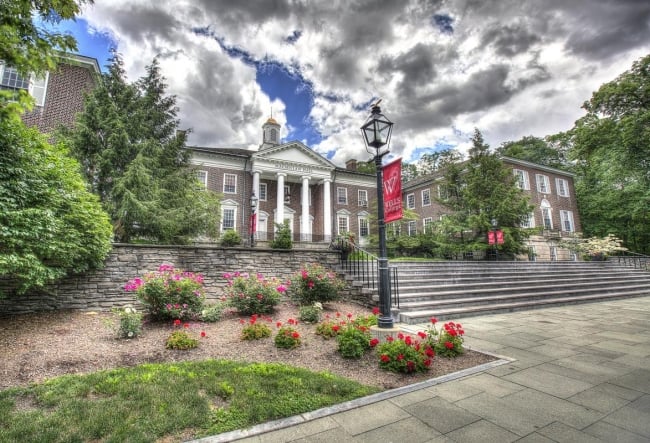You have /5 articles left.
Sign up for a free account or log in.

Wells College fits the profile of institutions that stand to lose the most amid the coronavirus pandemic.
Courtesy of Wells College
Last week, the president of Wells College sent a letter to college constituencies with a clear, critical message: if Wells cannot reopen in person this fall, it may have to close its doors permanently.
“If New York State continues its mandate that our campus remain closed through all or part of the fall semester, Wells simply will not receive enough revenue to continue operations,” the college's president, Jonathan Gibralter, wrote.
Wells College fits the profile of institutions that stand to lose the most as a result of the pandemic. It’s a private, nonprofit, four-year college with fewer than 500 students, sitting in small-town Aurora, N.Y. The college has little in cash reserves and a small $24 million endowment, of which only 15 percent is accessible for general spending.
Wells makes its money through student fees and other student-driven revenue. According to a fiscal 2018 audit, nearly 70 percent of the college’s operating revenue comes from tuition, fees and room and board. If students cannot live on campus, a significant source of revenue is missing, Gibralter said.
He is also worried students may choose to take a gap year in lieu of another semester online, which would impact not only room and board dollars but also tuition revenue.
“I’m hearing from some students that if they have to do fully online again, they would probably opt out for a year,” Gibralter said.
For comparison, Hamilton College is a less than a two-hour drive away in Clinton, N.Y. Hamilton and Wells share many institutional characteristics -- Hamilton is also a private, nonprofit, four-year college, and it serves 2,000 students. Student fees make up just over 60 percent of its operating revenue, according to a fiscal 2018 audit.
But Hamilton sits on a $969 million endowment -- the 40th largest per-student endowment in the country, according to National Association of College and University Business Officers statistics. Several years ago the college set aside a rainy day fund for emergency scenarios, including a pandemic. Without the fund and the endowment, the college would be in trouble, according to Karen Leach, Hamilton's chief financial officer.
“I think that there are many schools that are strapped for cash, and many schools that don’t have endowments, and it would be very hard for us without those two resources,” Leach said.
Wells College also relies on revenue from its study abroad program based in Florence, Italy. The program brings in about 15 percent of the college’s operating revenue, said Carl Sgrecci, Wells's chief financial officer.
Italy was hit hard by the pandemic early in the year. Infection rates and death tolls rose sharply as the virus searched for a foothold in the United States. Death rates began to slowly decline in late March, though as of Thursday, Italy still has the sixth most active cases in the world, according to Worldometer.
“We don’t know what the future holds for Florence, Italy, right now, and we won’t know until we get further along into next year,” Gibralter said. “If it’s possible and if parents are willing to send their kids to Florence, that will help. But we’re thinking realistically that it may be another year until that is actually able to start to recover.”
At the moment, Wells and other New York colleges are at the mercy of the state. Reopening higher education falls under Phase 4 of Governor Andrew Cuomo’s reopening plan -- behind construction, retail, real estate and restaurants. “Phase 4 means when you have students on campus. It makes perfect sense that we would be in Phase 4. But we know that there is a lot of runway that would need to be covered before we bring students on campus,” said Mary Beth Labate, president of the Commission on Independent Colleges and Universities in New York.
New York has been a hotspot for the coronavirus since shortly after the virus arrived in the United States. A majority of cases are concentrated in and around New York City. Cayuga County, where Wells is located, has a far lower number of positive cases. As of Thursday, 60 people had tested positive for the virus out of a total 1,416 tests.
“We have some information that the Finger Lakes may open sooner than downstate and other areas, and we feel really good about that,” Gibralter said.
Pressed on when colleges will be able to reopen in a radio interview, Cuomo’s message was it’s too soon to tell.
“Tell me what the drop-dead date is for them to send out notices and bring students back, and let’s make a final decision the day before with the best information available,” he told Alan Chartock on WAMC Thursday. “Even then, the facts may change the next week, right. Who would be shocked if they said, ‘Oh, by the way, we just found out, the coronavirus affects 22-year-olds’?”
While they wait for a decision on reopening, Gibralter and his team have been communicating with the governor’s office, as well as state lawmakers, Assemblyman Gary Finch and Senator Pam Helming, to make preparations for the fall, access necessary personal protective equipment and disinfecting capabilities, and push for financial assistance for colleges in the state.
CICU is looking at how to implement social distancing on college campuses, potential changes to the academic calendar and the best way to go about testing for the virus on campuses.
To cut down on expenses, Wells College has required employees making more than $50,000 to take a 6 percent salary reduction. Employees making less than $50,000 are required to take eight unpaid furlough days, which amounts to a 3 percent salary reduction. This will save the college about $450,000 this fiscal year, Sgrecci said. In recent years, operating expenses at Wells came in around $23 million annually, according to its most recently available financial statement.
Wells also qualified for the federal government’s Paycheck Protection Program, which has allowed it to keep all employees on payroll. So far, no employees have been laid off or furloughed.
On Tuesday, after Gibralter sent his message to the community, he was feeling optimistic.
“I got so much feedback from dozens and dozens of people -- alumni, students, families -- who all said, ‘What can we do to help?’” he said. In response to the feedback, the college announced on Wednesday a fundraising effort with the goal of collecting about $4.7 million to help the college continue operations in the fall.
Wells is also pushing CICU’s e-advocacy campaign, urging students to encourage federal lawmakers to appropriate more money for higher education in a future stimulus bill.
Reopening New York colleges this fall is possible, Labate said, but it will require flexibility and creativity from colleges.
"It’s going to have to look and feel a lot different than it looks and feels now," she said. "But if any industry can figure it out despite all of the complexities, it will be, I think, higher ed."








